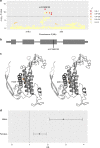Genome-wide meta-analysis implicates mediators of hair follicle development and morphogenesis in risk for severe acne
- PMID: 30542056
- PMCID: PMC6290788
- DOI: 10.1038/s41467-018-07459-5
Genome-wide meta-analysis implicates mediators of hair follicle development and morphogenesis in risk for severe acne
Abstract
Acne vulgaris is a highly heritable common, chronic inflammatory disease of the skin for which five genetic risk loci have so far been identified. Here, we perform a genome-wide association study of 3823 cases and 16,144 controls followed by meta-analysis with summary statistics from a previous study, with a total sample size of 26,722. We identify 20 independent association signals at 15 risk loci, 12 of which have not been previously implicated in the disease. Likely causal variants disrupt the coding region of WNT10A and a P63 transcription factor binding site in SEMA4B. Risk alleles at the 1q25 locus are associated with increased expression of LAMC2, in which biallelic loss-of-function mutations cause the blistering skin disease epidermolysis bullosa. These findings indicate that variation affecting the structure and maintenance of the skin, in particular the pilosebaceous unit, is a critical aspect of the genetic predisposition to severe acne.
Conflict of interest statement
The authors declare no competing interests.
Figures


Comment in
-
From genome-wide association to biological explanation.Br J Dermatol. 2019 Dec;181(6):1113-1114. doi: 10.1111/bjd.18462. Br J Dermatol. 2019. PMID: 31797373 No abstract available.
References
Publication types
MeSH terms
Substances
Grants and funding
LinkOut - more resources
Full Text Sources
Medical
Miscellaneous

